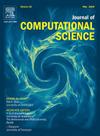Autonomous underwater vehicle path planning using fitness-based differential evolution algorithm
IF 3.1
3区 计算机科学
Q2 COMPUTER SCIENCE, INTERDISCIPLINARY APPLICATIONS
引用次数: 0
Abstract
The enhanced capabilities of autonomous underwater vehicles (AUVs) will facilitate sustainable exploration and utilization of maritime resources through improved precision in underwater mapping, resource extraction, and environmental surveillance. Enhanced navigation and communication systems will bolster the robustness and flexibility of AUVs, opening up new avenues for research and operations in demanding underwater conditions. The objective of this initiative is to optimize the performance of AUVs by developing sophisticated navigation methodologies specifically designed for complex marine environments. To achieve this goal, this paper proposes a modified structure of the well-known metaheuristic called differential evolution (DE). The proposed algorithm is denoted by a fitness-based differential evolution algorithm (FDE). Through the utilization of path planning techniques and the application of the proposed FDE to enhance navigation, this paper seeks to overcome obstacles such as underwater barriers, restricted communication, and limited visibility. These enhancements are anticipated to notably elevate the efficacy and cognitive capabilities of AUVs. The validation of the proposed FDE algorithm is conducted on nine case studies of the path planning of AUV, and the comparison is made with other metaheuristic algorithms. The comparison indicates the effectiveness of the FDE in solving the AUV path planning problem.
求助全文
约1分钟内获得全文
求助全文
来源期刊

Journal of Computational Science
COMPUTER SCIENCE, INTERDISCIPLINARY APPLICATIONS-COMPUTER SCIENCE, THEORY & METHODS
CiteScore
5.50
自引率
3.00%
发文量
227
审稿时长
41 days
期刊介绍:
Computational Science is a rapidly growing multi- and interdisciplinary field that uses advanced computing and data analysis to understand and solve complex problems. It has reached a level of predictive capability that now firmly complements the traditional pillars of experimentation and theory.
The recent advances in experimental techniques such as detectors, on-line sensor networks and high-resolution imaging techniques, have opened up new windows into physical and biological processes at many levels of detail. The resulting data explosion allows for detailed data driven modeling and simulation.
This new discipline in science combines computational thinking, modern computational methods, devices and collateral technologies to address problems far beyond the scope of traditional numerical methods.
Computational science typically unifies three distinct elements:
• Modeling, Algorithms and Simulations (e.g. numerical and non-numerical, discrete and continuous);
• Software developed to solve science (e.g., biological, physical, and social), engineering, medicine, and humanities problems;
• Computer and information science that develops and optimizes the advanced system hardware, software, networking, and data management components (e.g. problem solving environments).
 求助内容:
求助内容: 应助结果提醒方式:
应助结果提醒方式:


